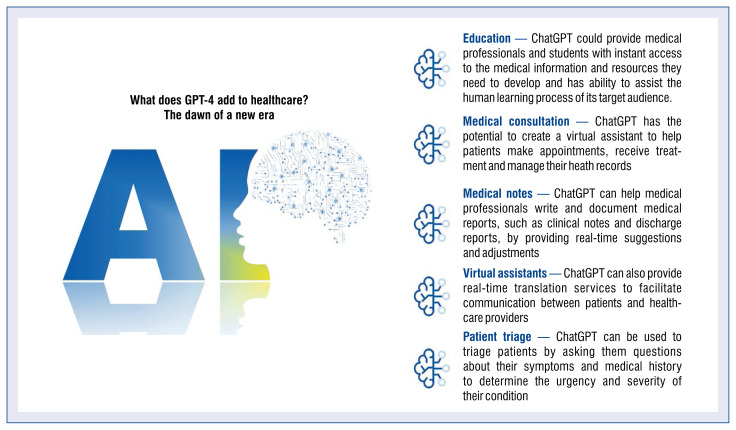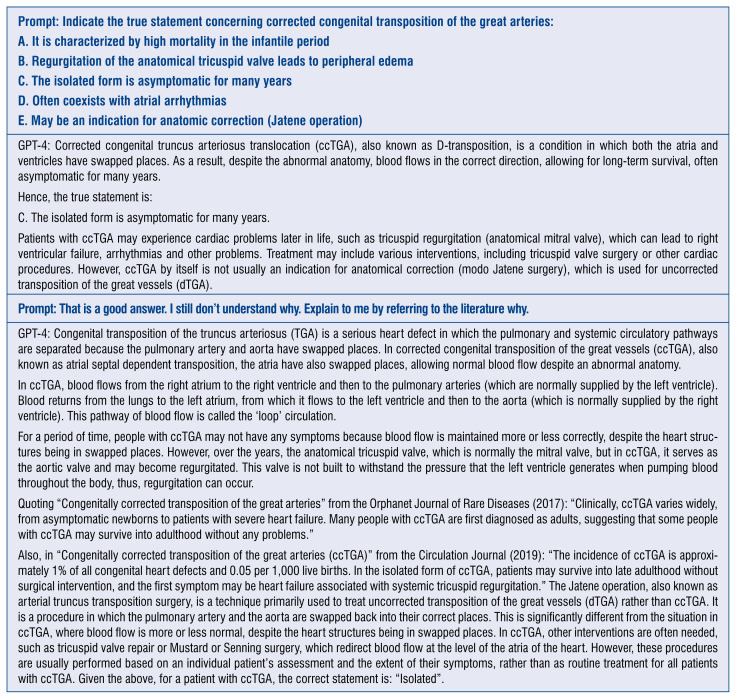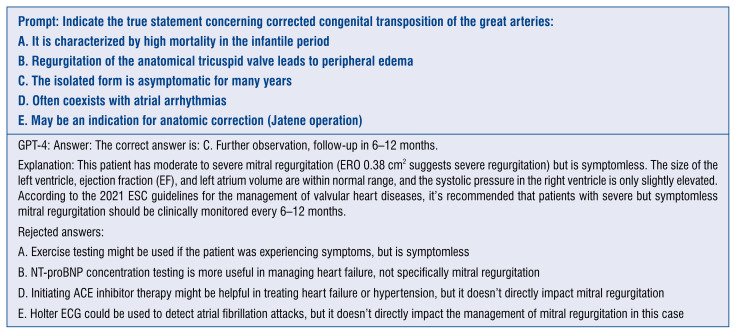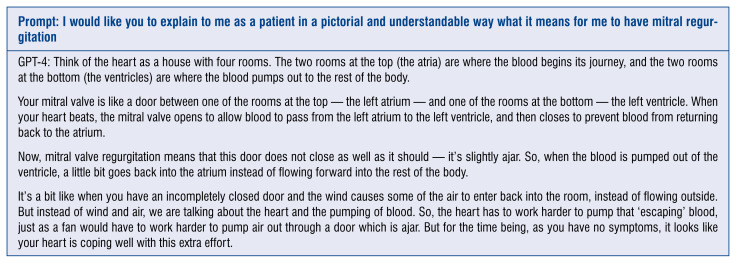Abstract
Over the past few years, artificial intelligence (AI) has significantly improved healthcare. Once the stuff of science fiction, AI is now widely used, even in our daily lives — often without us thinking about it. All healthcare professionals — especially executives and medical doctors — need to understand the capabilities of advanced AI tools and other breakthrough innovations. This understanding will allow them to recognize opportunities and threats emerging technologies can bring to their organizations. We hope to contribute to a meaningful public discussion about the role of this new type of AI and how our approach to healthcare and medicine can best evolve with the rapid development of this technology.
Since medicine learns by example, only a few possible uses of AI in medicine are provided, which merely outline the system’s capabilities.
Among the examples, it is worth highlighting the roles of AI in medical notes, education, preventive programs, consultation, triage and intervention.
It is believed by the authors that large language models such as chat generative pre-trained transformer (ChatGPT) are reaching a level of maturity that will soon impact clinical medicine as a whole and improve the delivery of individualized, compassionate, and scalable healthcare. It is unlikely that AI will replace physicians in the near future. The human aspects of care, including empathy, compassion, critical thinking, and complex decision-making, are invaluable in providing holistic patient care beyond diagnosis and treatment decisions. The GPT-4 has many limitations and cannot replace direct contact between an experienced physician and a patient for even the most seemingly simple consultations, not to mention the ethical and legal aspects of responsibility for diagnosis.
Keywords: ChatGPT, innovations, artificial intelligence, AI in medicine, health IT
Introduction
Over the past few years, artificial intelligence (AI) has significantly improved healthcare. What was once a concept relegated to the realms of science fiction is now a common feature in our everyday existence, seamlessly integrating without our conscious acknowledgment. However, it was only a short while ago that AI could not understand the content. AI could read and write, but it lacked the next level of intelligence that comes from understanding. With chat generative pre-trained transformer (ChatGPT), that next level has been truly unlocked. Major technology companies are in a competitive race to integrate technology, especially large language models (LLMs), into their products and services. One of the most well-known AI-driven tools is ChatGPT, a natural language processing model crafted by OpenAI. OpenAI, with support from Microsoft, is developing some increasingly powerful AI systems, GPT-4 the most sophisticated among them, has been openly available since March 2023.
ChatGPT uses a neural transformer network to process and generate text independently. In this way, it can answer users’ questions and interact with them via chat, using natural language and trying to provide coherent and relevant answers to their questions. LLMs have demonstrated remarkable capabilities in natural language understanding and generation across various fields, including medicine. We anticipate that GPT-4 might soon be eclipsed by more potent and adept AI entities, marking the ascendancy of a new echelon of machines characterized by enhanced power and intelligence [1]. Given its potential, the tool immediately underwent extensive testing. The prompt can be presented as a question and as an instruction for a specific task, e.g., “Please read and summarize this article on medical research” or “Please read and summarize the last European Society of Cardiology guidelines on arterial hypertension”. Furthermore, prompts are not limited to English sentences; they can be written in various human languages and include inputs such as spreadsheets, technical outlines, academic journals, and complex mathematical formulations [2].
The potential applications of LLM in education, research, and healthcare can be promising if the essential issues involved are proactively explored and addressed. Few industries are as data-rich and text-heavy and have as high a critical need for automation as healthcare. In addition to these characteristics, an acute information asymmetry exists for both patients and clinicians alike; patients want to be better informed about their condition, and clinical teams crave more up-to-date, easily accessible insights about their patients and populations to better inform them about the healthcare they deliver. In this context, AI can provide comprehensive and accurate medical advice and information from multiple independent sources to better inform and educate patients about their conditions or symptoms.
All healthcare professionals — especially executives and medical doctors, should grasp the potential of advanced AI tools and other breakthrough innovations. Hence, they know what opportunities and threats emerging technologies can bring to their organizations. We hope to contribute to a meaningful public discussion about this new form of AI and discuss how healthcare and medicine can adapt to keep pace with the swift advancements in this technology. The key values are presented in the Central illustration.
Central illustration.
What does GPT-4 add to healthcare? The dawn of a new era.
How can AI bring greater value to the broader healthcare system and support clinical practice?
The goal in this study is to highlight AI’s potential applications and limitations in healthcare and cardiology, used efficiently in two main streams: IT and robots. The first stream allows for improved control of service management systems health such as electronic medical records and is also used in software used to analyze medical images such as angiography, echocardiography, computer tomography, magnetic resonance imaging of the heart, endovascular ultrasonography, and technologies such as machine learning, deep learning, and natural language processing such as in automated support systems’ clinical decisions. The second stream (robotic) is used in interventional cardiology to perform percutaneous coronary artery procedures. An interventional cardiologist can control the device from a separate room, eliminating the need to wear heavy protective clothing and reducing risks of radiation exposure and orthopedic injuries [2].
Since the field of medicine often advances through real-world examples, only a few examples of possible uses of AI in medicine are provided, which merely outlines the system’s capabilities.
Example 1: Medical notes
ChatGPT can help medical professionals in composing and documenting medical records, including clinical notes and discharge reports, by offering real-time suggestions and adjustments [3]. In March 2023, Nuance Communications, a part of Microsoft, unveiled its latest speech-enabled medical writing application integrated with GPT-4. The new application aims to leverage Nuance’s ability to capture, analyze, and distill the content of physician visits with patients to reduce physician workload, particularly administrative tasks and paperwork. A study by the American Medical Association found that for every hour physicians spend on patient visits, they spend nearly 2 hours on electronic medical records and desk work during work hours. In the proposed implementation of this feature, once the patient gives consent, GPT-4 captures the transcriptand processes the conversation between the doctor and patient in a manner similar to today’s “smart speakers”.
After the session, the software creates a note at the provider’s request. GPT-4 can make notes in several formats and automatically insert the appropriate billing codes. In addition to notes, GPT-4 can also answer questions about the consultation, extract information about prior authorizations, create lab orders and prescriptions, or write postvisit summaries and provide critical feedback to the physician and patient [3]. In a proposed use of this feature, after the patient gives consent, GPT-4 would obtain the transcript by listening to the doctor-patient encounter like today’s “smart speakers” do. After the meeting, the software would generate the transcript at the doctor’s request. GPT-4 can create notes in familiar formats, such as SOAP (subjective, objective, assessment, and plan), and automatically insert appropriate billing codes. Beyond the findings, GPT-4 can answer questions about the exam, extract pre-authorization information, generate lab and prescription orders that meet Health Level Seven Fast Healthcare Interoperability Resources standards, generate post-exam summaries, and provide critical feedback to the physician and patient [4].
Example 2: Education
Moreover, ChatGPT-4 has the potential to improve medical education. The system could provide medical professionals and students with instant access to the medical information and resources they need for their development.
ChatGPT demonstrated its proficiency when tasked with answering a series of questions typically found on the standardized tests that United States universities administer for medical licensure. A collective of researchers from multiple American universities conducted an experiment tasked with answering a series of questions on the standard tests that United States universities use to grant or deny licensure to practice medicine, ChatGPT proved more than capable of passing the exam. A collective of researchers from multiple American universities conducted an experiment where ChatGPT was subjected to the United States Medical Licensing Examination (USMLE) without any specific preparation tutoring. The exam consists of three sections with questions covering most medical subjects, from biochemistry to diagnostic reasoning to bioethics. Before the test, the researchers reviewed the questions and deleted those related to interpreting radiological and other images (which requires specialized training), leaving 350 out of 376 questions. As detailed in PLoS Digital Health, ChatGPT’s performance was commendable, securing between 52.4% and 75% accurate responses [5, 6].
With an average passing rate hovering around 60%, the chances of success for the AI system would be very high. In addition, ChatGPT had an unusually high percentage of coherent responses — 94.6%. No answers contradicted each other, and in 88.9% of its solutions, it offered explanations that were not trivial or obvious, revealing some intuition [7]. It is worth noting that a similar system developed by the world’s largest database of scientific publications, PubMed (PubMedGPT), could only answer up to 50% of the answers correctly in the same USMLE exam, far behind ChatGPT. ChatGPT also allows for summarizing the published scientific data to keep clinicians informed [6].
Inspired by the remarkable performance of ChatGPT on the USMLE, a similar experiment was conducted on the equivalent exam in Poland, the LEK (note: prompts were given in Polish). According to Polish law, to obtain full qualifications allowing access to practice the profession of a physician/dentist in Poland, the holder of the Lekarz (MD) or Lekarz Dentysta (DMD) degree diploma has to pass the Medical/Dental Final Examination — LEK/LDEK, which is organized and carried out by the Medical Examination Center in Lodz. A typical LEK problem (question statistics: 66.7% correct answers), along with the ChatGPT-4 response (shown in Fig. 1), where ChatGPT-4 explains its reasoning, refers to known medical facts, highlights causal correlations, references and literature, excludes other proposed responses and furnishes persuasive reasoning to support its selected response.
Figure 1.
ChatGPT-4 explains its reasoning, refers to known medical facts, notes causal relationships, and literature, excludes other proposed responses and provides convincing justification for its ‘decision’.
For the more difficult questions on the LEK exam, illustrated in Figure 2, GPT-4 also showed a high success rate, with only 41.6% of students marking the correct answer, which confirms Chat-GPT-4’s ability to assist the human learning process of its target audience.
Figure 2.
ChatGPT-4 explains its reasoning, refers to known medical facts, notes causal relationships, and literature, excludes other proposed responses and provides convincing justification for its ‘decision’ in more difficult cases; ESC — European Society of Cardiology; NT-proBNP — N terminal pro-B-type natriuretic peptide; ACE — angiotensin converting enzyme; ECG — electrocardiogram.
ChatGPT must be continuously fed with the most current publications for maximum effectiveness. This practical application of the tool would benefit the clinician and the healthcare system while avoiding the risk of AI making the final clinical decisions, as trust in this area is intangible. This medical knowledge makes GPT-4 potentially valuable for the clinical setting and academic research. GPT-4 can digest medical research and discuss its contents, offering summaries, analyzing data, referencing past studies, assessing findings, and suggesting areas for future research [8].
This artificial intelligence system has also shown that it has excellent potential to help students train and prepare so that they can use it to study for exams and enhance their knowledge. The authors of the present study employed ChatGPT to refine the initial draft of the article, ensuring logical coherence and clarifying ambiguous sections [4].
Example 3: Medical consultation
For typical initial medical consultations, including information about a patient’s presentation or summaries of laboratory test results, GPT-4 provides valuable answers that can help the physician who makes a request to resolve an issue. Because of the interactive nature of the system, the user can clarify the solutions by asking for more specifics or by requesting more concise answers to get “to the point” more quickly [1]. ChatGPT can also provide instantaneous translation services to bridge the communication gap between patients and healthcare professionals. Thanks to its advanced language processing skills, ChatGPT is adept at swiftly and precisely translating complex medical terminology, technical phrases, and everyday language. This ensures patients are well-informed about their diagnoses, available treatment alternatives, and directions for medication. ChatGPT is already being used in some United States hospitals to transcribe more complex reports so patients can better understand the results of an exam, diagnosis, or treatment [4].
Limited literacy skills are among the strongest predictors of poor patient health outcomes. As communication barriers may go undetected in healthcare settings and can have severe effects on the health and safety of patients, ChatGPT-4 abilities in this area were tested. Figure 3 presents an example of how ChatGPT-4 can simplify and visually explain medical jargon to patients.
Figure 3.
How ChatGPT-4 can easily and pictorially explain medical jargon to a patient.
GPT-4’s wealth of medical knowledge is beneficial not just in patient care but also for research purposes. It can delve into medical studies, offer informed perspectives, summarize key points, perform technical analyses, reference related works, evaluate the findings, and suggest areas for additional research.
Example 4: Patient triage
ChatGPT can be employed for patient triage, where it queries patients about their symptoms and medical history, helping to assess the severity and urgency of their condition. AI will likely support medical practice by helping physicians use technology to improve clinical care. Technology will not replace human intelligence but will complement it [4, 9].
Example 5: Virtual assistants
ChatGPT has the potential to create a virtual assistant to help patients make appointments, receive treatment, and manage their health records. With the rise in telemedicine popularity, an increasing number of patients are opting for treatments within the comfort of their home. A virtual assistant powered by ChatGPT can offer the necessary guidance and assistance for patients to effectively oversee their health from a distance. The virtual assistant can provide accurate and precise answers without being burdened by human emotions or adverse reactions to stressful situations [4].
Example 6. Clinical use
Back to the topic of robotic AI, the significance of R-One can hardly be overstated. This robotic percutaneous coronary intervention (PCI) system is engineered to diminish radiation exposure to the operator, enhance ergonomics, and ensure precise navigation and delivery of guidewires/devices during PCI procedures [10]. The European multicentre R-EVOLUTION study, which was prospective in nature, involved patients experiencing de novo coronary artery stenosis (with a length of < 38 mm and reference diameter between 2.5–4.0 mm) who were undergoing the process of stent implantation. Researchers made a distinction between clinical and technical achievement. The former referred to the lack of significant complications during the procedure, while the latter related to the successful maneuvering and removal of all PCI tools (like guidewires, balloons, and stents) without fully manual adjustments. The R-EVOLUTION research encompassed 62 ongoing patients (with B2/C lesions making up 25.0% or 16 out of 64) who underwent robotic PCI. The primary method of access was radial, utilized in 96.8% or 60 out of the 62 operations. The average duration for the robotic procedure was approximately 19.9 ± 9.6 minutes, and the average time for fluoroscopy was around 10.3 ± 5.4 minutes. It is worth noticing that clinical success was 100%, and technical success was 95.2% (59/62). Exposure to radiation for the operator decreased by 84.5% beneath and 77.1% above the lead apron when contrasted with doses noted on the patient table. The R-Evolution research deems the robotic PCI with R-One to be a reliable and efficient instrument, significantly minimizing radiation contact for the user [10].
ChatGPT could assist in the global obesity pandemic by offering personalized dietary and exercise advice based on individual user inputs and current scientific guidelines. By analyzing vast amounts of research data, ChatGPT can provide up-to-date information on effective obesity prevention and treatment strategies to both healthcare professionals and the public. Through interactive sessions, ChatGPT can motivate and educate individuals about the importance of lifestyle changes, helping to track progress and set realistic goals. For healthcare professionals, ChatGPT can serve as a tool to quickly access the latest research on obesity-related diseases, ensuring that patients receive evidence-based care. ChatGPT could be integrated into telemedicine platforms, allowing patients struggling with obesity to have consistent access to guidance and support, regardless of their geographical location.
ChatGPT is designated as an innovative tool in the field of education and raising awareness about the dangers of smoking. Its ability to provide accurate information in real-time can serve as a platform for educating people about the health effects associated with smoking. Through interactive sessions, ChatGPT has the potential to motivate smokers to quit the habit. In the digital age, such technologies can become a key component of public health strategies aimed at reducing smoking.
Discussion
The most critical point is that GPT-4 is not an end but opens the door to new opportunities and threats. GPT-4 and similar AI systems have enormous potential in medicine, but their use should be approached with caution and consideration of the limitations and risks involved [11].
Thus, while this new multimodal model is impressive, much room exists for improvement. Like every other pre-trained model before it, GPT-4 is limited by its training data, and the question of what constitutes acceptable overall AI performance still needs to be answered. How should the general intelligence of a tool like GPT-4 be evaluated? To what extent can users ‘trust’ GPT-4, or must they take the time to verify its accuracy? Despite its enormous potential, critical ethical issues cannot be ignored when discussing ChatGPT. The emergence of ChatGPT and similar advanced AI technologies marks a pivotal moment in the evolution of AI. It becomes crucial to deliberate on the ethical and safe deployment of these progressively intelligent and potent tools. Other ethical issues must be considered when implementing AI tools in the medical community. The most important cases for healthcare involve privacy and security. When using ChatGPT, users give it data; that data is often confidential patient information in healthcare. This has massive privacy implications, as systems must be in place to ensure the confidentiality of patient data before ChatGPT can be widely used in healthcare. In addition, there is a risk that patients will unknowingly trust that the system is 100% accurate at all times due to the incredible capabilities of ChatGPT. ChatGPT is better suited as a supportive tool rather than a complete solution, and all work and information it provides must be verified. In the event of an error, the AI-generated information provided by ChatGPT could affect a person’s health; therefore, extreme caution should be exercised [3]. In clinical medicine and medical ethics, the patient-physician relationship is crucially based on a solid ethical and legal framework. Physicians take the Hippocratic Oath at the beginning of their careers, on the first day of medical school, which commits them to patient welfare and confidentiality. These two crucial dogmas of the medical code are most affected by AI when it comes to protecting patient data and misdiagnosis. Introducing artificial intelligence leads to a complex relationship between physician and patient and AI. It is difficult to determine whether the third actor in this extended relationship is the human behind the code or the AI itself, triggering a profound debate about liability [1, 11].
Addressing ethical, regulatory, and policy issues is crucial when designing, implementing, and incorporating AI applications and system components. Due to usability and safety concerns, new applications must meet the same standards as other medical technologies. This requires a similar level of rigor in testing as in other areas of medicine [8].
In essence, ChatGPT holds the promise to refine and enhance healthcare delivery significantly. It is poised for broad acceptance, and is expected to instigate transformative changes akin to the impact the internet has made on the industry. Nonetheless, the deployment of such technology should be judicious, with healthcare decisions firmly rooted in the expertise of qualified healthcare professionals.
Conclusions
It is believed herein, that LLMs such as ChatGPT are reaching a level of maturity that will soon impact clinical medicine as a whole and improve the delivery of individualized, compassionate, and scalable healthcare. It is unlikely that AI will replace physicians in the near future. The human aspects of care, including empathy, compassion, critical thinking, and complex decision-making, are invaluable in providing holistic patient care beyond diagnosis and treatment decisions. ChatGPT-4 has many limitations and cannot replace direct contact between an experienced physician and a patient for even the most seemingly simple consultations, not to mention the ethical and legal aspects of responsibility for diagnosis. In conclusion, half-jokingly, half seriously, chatbots, algorithms, and AI will not replace the doctor but will remain a great tool in his hands as long as the laws of robotics cannot be effectively extended to the Hippocratic Oath.
References
- 1.Waisberg E, Ong J, Paladugu P, et al. Challenges of artificial intelligence in space medicine. Space: Sci Technol. 2022:2022. doi: 10.34133/2022/9852872. [DOI] [Google Scholar]
- 2.Johnson KW, Torres Soto J, Glicksberg BS, et al. Artificial Intelligence in Cardiology. J Am Coll Cardiol. 2018;71(23):2668–2679. doi: 10.1016/j.jacc.2018.03.521. [DOI] [PubMed] [Google Scholar]
- 3.Lee P, Bubeck S, Petro J. Benefits, limits, and risks of GPT-4 as an AI chatbot for medicine. N Engl J Med. 2023;388(13):1233–1239. doi: 10.1056/NEJMsr2214184. [DOI] [PubMed] [Google Scholar]
- 4.Marr Bernard. Medicine And Wellness [online] Forbes; 2023. [Accessed April 2023]. Revolutionizing Healthcare: The Top 14 Uses Of ChatGPT. https://www.forbes.com/sites/bernardmarr/2023/03/02/revolutionizing-healthcare-the-top-14-uses-of-chatgpt-in-medicine-and-wellness/ [Google Scholar]
- 5.Kung TH, Cheatham M, Medenilla A, et al. Performance of ChatGPT on USMLE: Potential for AI-assisted medical education using large language models. PLOS Digit Health. 2023;2(2):e0000198. doi: 10.1371/journal.pdig.0000198. [DOI] [PMC free article] [PubMed] [Google Scholar]
- 6. [Accessed April 2023]. https://www.ibsafoundation.org/en/blog/chatgpt-passes-medical-licensing-examination .
- 7.Haug CJ, Drazen JM. Artificial intelligence and machine learning in clinical medicine, 2023. N Engl J Med. 2023;388(13):1201–1208. doi: 10.1056/NEJMra2302038. [DOI] [PubMed] [Google Scholar]
- 8.Beam AL, Drazen JM, Kohane IS, et al. Artificial Intelligence in Medicine. N Engl J Med. 2023;388(13):1220–1221. doi: 10.1056/NEJMe2206291. [DOI] [PubMed] [Google Scholar]
- 9. [Accessed April 2023]. https://www.news-medical.net/health/What-does-ChatGPT-mean-for-Healthcare.aspx .
- 10.Durand E, Sabatier R, Smits PC, et al. Evaluation of the R-One robotic system for percutaneous coronary intervention: the R-EVOLUTION study. EuroIntervention. 2023;18(16):e1339–e1347. doi: 10.4244/EIJ-D-22-00642. [DOI] [PMC free article] [PubMed] [Google Scholar]
- 11.Henderson Emily., BSc What does ChatGPT mean for Healthcare? 2023. [Accessed April 2023]. https://www.news-medical.net/health/What-does-ChatGPT-mean-for-Healthcare.aspx .






